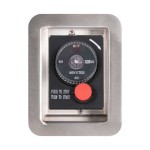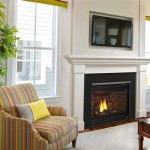Painting The Fireplace: A Comprehensive Guide
A fireplace serves as a focal point in many homes, often contributing significantly to the room's overall aesthetic. Over time, however, the fireplace's original appearance can become worn or outdated, detracting from its visual appeal. Painting the fireplace is a cost-effective and relatively simple method for updating its look and integrating it seamlessly into a new or existing design scheme. This article provides a detailed guide on how to approach painting a fireplace, covering preparation, material selection, the painting process, and crucial safety considerations.
Before embarking on a painting project, a thorough assessment of the fireplace’s current state is vital. This assessment involves identifying the material composition of the fireplace surround (e.g., brick, stone, concrete, wood) and evaluating its condition. Cracks, chips, or crumbling mortar should be addressed before any painting commences. Additionally, consider the existing finish on the fireplace. Previous paint layers, soot, and grime can all affect the adhesion and appearance of the new paint. Proper preparation is the foundation of a successful and long-lasting paint job.
Essential Preparations: Cleaning and Repairing the Fireplace
The initial step in preparing the fireplace for painting is a thorough cleaning. Accumulated soot and dust will impede paint adhesion and compromise the final result. The cleaning process varies depending on the fireplace material. For brick fireplaces, a wire brush and a solution of trisodium phosphate (TSP) diluted in water is generally effective. TSP is a strong cleaner, so appropriate protective gear, including gloves and eye protection, is crucial during its use. The solution should be applied to the brick surface, scrubbed vigorously to remove grime, and then rinsed thoroughly with clean water. For stone fireplaces, a similar cleaning process can be employed, but care should be taken to avoid damaging delicate or porous stone. A gentler cleaning solution might be necessary for softer stone types.
Wood fireplaces, if paintable, require a different approach. A degreasing cleaner is recommended to remove any existing grease or wax buildup. Avoid using harsh chemicals on wood, as they can damage the finish. After cleaning, allow the fireplace to dry completely. Drying time will vary depending on the material, but it's generally advisable to wait at least 24 hours to ensure complete dryness.
Following the cleaning stage, any necessary repairs should be undertaken. Cracks in brick or stone should be filled with mortar or masonry patching compound. Loose or crumbling mortar joints should be raked out and re-pointed. For wooden fireplaces, fill any holes or imperfections with wood filler, allowing it to dry completely before sanding smooth. Sanding creates a uniform surface for the paint to adhere to. Use sandpaper with varying grits, starting with a coarser grit to remove imperfections and finishing with a finer grit to create a smooth finish. Ensure all sanding dust is removed before proceeding to the next step.
Masking is another critical aspect of preparation. Use painter's tape to protect surrounding surfaces, such as walls, floors, and any decorative elements. This step will prevent paint from accidentally spreading onto unwanted areas and ensure clean, crisp lines. It's important to use a high-quality painter's tape that provides a strong seal and removes cleanly without leaving residue.
Selecting the Right Paint and Primer
Choosing the appropriate paint and primer is crucial for achieving a durable and aesthetically pleasing finish on a fireplace. The material of the fireplace dictates the type of paint and primer suitable for the project. For brick and stone fireplaces, masonry paint is the preferred choice. Masonry paint is formulated to withstand the high heat and fluctuating temperatures associated with fireplaces. It is also breathable, allowing moisture to escape from the masonry, preventing cracking and peeling.
Latex-based masonry paint is a popular option due to its ease of application and cleanup. However, for fireplaces that are frequently used, a higher-quality acrylic masonry paint is recommended. Acrylic paint offers superior durability and resistance to heat. For wood fireplaces, a high-quality acrylic latex paint designed for interior use is generally suitable. Ensure the paint is formulated to withstand moderate heat, even if the wood is located further away from the actual firebox.
Primer plays a vital role in ensuring proper paint adhesion and providing a uniform base for the topcoat. For brick and stone fireplaces, a masonry primer is recommended. This type of primer seals the porous surface of the masonry, preventing the paint from being absorbed unevenly. It also helps to block stains and efflorescence, a white, powdery substance that can appear on brick and stone surfaces. For wood fireplaces, a standard interior primer designed for wood surfaces is appropriate. Choose a primer that is compatible with the chosen paint type (e.g., latex primer for latex paint, oil-based primer for oil-based paint). Apply the primer in thin, even coats, allowing it to dry completely before applying the paint.
The sheen of the paint is another factor to consider. Matte or eggshell finishes are often preferred for fireplaces as they provide a more subtle and natural look. Semi-gloss or gloss finishes can be used to highlight certain architectural details, but they can also accentuate imperfections. Consider the overall design scheme and the desired aesthetic when selecting the paint sheen.
When selecting colors, consider the room's existing palette and the desired ambiance. Neutral colors, such as white, gray, and beige, are popular choices for fireplaces as they create a clean and modern look. Bold colors can be used to make a statement, but it's important to ensure the color complements the surrounding décor. Before committing to a specific color, test it in a small, inconspicuous area to ensure it meets expectations.
The Painting Process: Application Techniques and Safety
Once the fireplace is properly prepared and the appropriate paint and primer have been selected, the painting process can begin. Start by applying a thin, even coat of primer to the entire fireplace surface. Use a brush for detail work and a roller for larger, flat areas. Allow the primer to dry completely according to the manufacturer's instructions. Drying times can vary depending on the ambient temperature and humidity.
After the primer has dried, apply the first coat of paint. Again, use a brush for detail work and a roller for larger areas. Ensure the paint is applied evenly, avoiding drips and runs. Allow the first coat to dry completely before applying the second coat. Multiple thin coats are generally preferable to one thick coat, as they provide better coverage and prevent the paint from cracking or peeling. The number of coats required will depend on the color and opacity of the paint, as well as the original color of the fireplace.
When painting brick or stone fireplaces, pay particular attention to the mortar joints. Use a brush to work the paint into the joints, ensuring they are fully covered. For textured surfaces, use a brush or roller with a nap that is appropriate for the texture. Avoid applying excessive pressure, as this can cause the paint to build up in the crevices.
Safety Precautions are very important during painting any fireplace. Proper ventilation is paramount when working with paint. Open windows and doors to allow fresh air to circulate. If ventilation is limited, use a respirator to protect against inhaling paint fumes. Wear gloves and eye protection to prevent paint from coming into contact with the skin and eyes. Keep children and pets away from the work area. Clean up spills immediately with a damp cloth. Dispose of paint cans and cleaning supplies properly according to local regulations.
After the final coat of paint has dried completely, carefully remove the painter's tape. Use a utility knife to score the edge of the tape before removing it to prevent the paint from peeling. Inspect the finished fireplace for any imperfections. Touch up any areas as needed with a small brush. Allow the paint to cure completely before using the fireplace. Curing times can vary depending on the type of paint and the ambient conditions.
By following these guidelines, painting a fireplace can be a successful project that enhances the beauty and value of the home. Remember that careful preparation, proper material selection, and attention to detail are essential for achieving a professional and long-lasting finish.

How To Paint A Fireplace Interior Design Diy Tips Direct Fireplaces

How To Paint Your Fireplace Brick Surround

How To Paint A Brick Fireplace Young House Love

How To Paint A Brick Fireplace Kippi At Home

Our Black Painted Fireplace Bright Green Door

Gorgeous Diy Fireplace Makeover 3 Reasons To Paint Your Black Lehman Lane

How To Paint Your Brick Fireplace Katie Lamb

7 Beautiful Ideas For Painting Interior Brick Fireplaces

How To Paint A Brick Fireplace
How To Update A Brick Fireplace With Chalk Paint Diy Beautify Creating Beauty At Home
Related Posts








